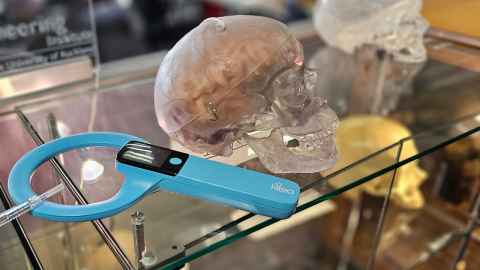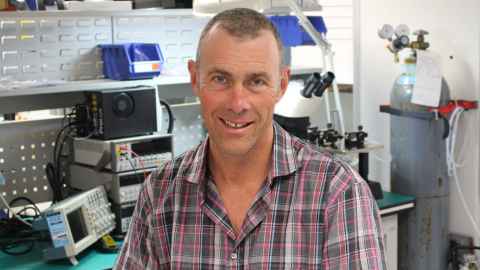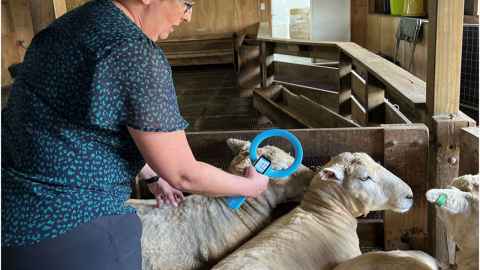First child receives potentially life-changing brain sensor
24 January 2025
Doctors and researchers in Auckland are leading a groundbreaking human trial for a wireless brain implant that allows families to monitor life-threatening pressure changes caused by hydrocephalus.

In a world-first human medical trial, a child has had a wireless sensor implanted into their brain to help detect a potentially life-threatening increase in brain pressure. Doctors at Auckland City Hospital successfully put the tiny sensor into a child with hydrocephalus, a condition that causes fluid to build up in the brain.
This follows sensors being implanted into the brains of adults with the same condition as part of the medical device trial.
The brain pressure sensor doesn’t treat the hydrocephalus – a tiny silicon tube does that, draining fluid from the brain harmlessly into the abdomen. What the new wireless device does is tell people if the tube is working properly – or not.
Shunts have been the standard treatment for hydrocephalus for decades, but they have a major flaw: they block easily, particularly in children, says Professor Simon Malpas, head of the team at the Auckland Bioengineering Institute and spin-off company Kitea Health that developed the pressure sensor.
Around 50 percent of shunts in children fail in the first two years, he says. When a shunt gets blocked it needs to be replaced fast before the raised pressure causes irrevocable damage or death. The trouble for doctors is that the symptoms of a failed shunt - headaches, nausea, tiredness and irritability - could just as easily be caused by something far less dangerous.
Adults with hydrocephalus (and parents of children with the condition) are constantly on a knife-edge looking out for symptoms and then having to decide whether to rush to hospital or go to bed with paracetamol.
Around 70 percent of the time when people turn up in the emergency room with symptoms that suggest their shunt might be failing, it’s a false alarm, Malpas says

Which is where the sensor comes in. The device looks like a small glass rectangle with a strip of electronics inside. It is 20mm long, 2mm by 3mm wide, and weighs just 0.3 grams.
It is implanted into the skull next to the drainage shunt when the shunt is replaced or when it is inserted for the first time. Once in the brain, an external “wand” waved over the person’s skull powers up the sensor, which takes a brain pressure reading. The person with hydrocephalus, or their parent, can see whether the pressure is raised (indicating a possible shunt failure), or normal (indicating something else is the cause of the symptoms).
Best of all, the readings don’t need to be done in hospital; the wand goes home with the patient after the implant operation.
“Parents of children with hydrocephalus have said to me numerous times that they know the shunt will fail, but they never know when. It’s like knowing your train will crash, and that’s very stressful," Malpas says.
"It’s bad enough for families close to a big hospital, but it’s even worse if it happens when you are in a rural area, hours from a specialist who can check out your symptoms. Should you move house? Should you go on holiday? We are offering the chance to monitor your child’s wellness from home.”
Clinicians are equally excited about the potential for the new sensor, Malpas says.
“Every emergency department I speak to says these things are happening every week and they are a nightmare. The parents are anxious, the child is screaming, and they have no idea if this is a shunt failure.”
It’s not unusual for a big New Zealand hospital to see four or five patients each week with a possibly blocked drainage tube.
“Physicians don’t want the risk of doing surgery when it’s not the shunt - there’s a significant risk drilling a hole in someone’s head.”

Fundraising and approvals
Before the current human trial was started, the sensor went through a rigorous testing process in the lab and then successful implantation in sheep at the University of Auckland’s Ngapouri Research Farm, Malpas says.
The present pilot involves small numbers – about 20 adult and child patients. But the next phase is a more extensive ‘pivotal’ trial, where 150 people in Aotearoa and the US will receive the sensor implant and doctors and researchers will look at impacts on clinical care and quality of life for patients.
The pivotal trial is set to start early in 2026, and once finished should allow Kitea Health to apply for regulatory approval in the US, Malpas says.
The company has raised $7 million over the last few months from venture capital funders including Icehouse Ventures, Pacific Channel, Cure Kids Ventures and the university’s own UniServices investment arm. It’s looking for another $3 million from the Snowball Effect investment marketplace and other funders, Malpas says.
The additional $10 million will mean the company can complete the safety trial, apply for US Food and Drug Administration (FDA) approval for the wider pivotal trial, and get approval for the sensor to be used in New Zealand.
“There’s a strong possibility we might be able to get regulatory approvals in New Zealand much sooner [than in the US], probably off the back of the trial that’s on now. There’s an opportunity for New Zealand patients to be the first in the world to be treated.”
Three days in a neurosurgical ward, and a couple of scans – that’s not cheap. We believe we can potentially reduce healthcare costs by 30 percent
Malpas is also looking for University of Auckland researchers with expertise in health economics to do a study on the cost benefits of the sensor for the New Zealand healthcare system and for patients.
“We think it saves money. Currently a patient comes in and might have a CT scan and an MRI. They will likely be admitted to hospital for monitoring.
“I’m not a health economist, but three days in a neurosurgical ward, and a couple of scans – that’s not cheap. We believe we can potentially reduce healthcare costs by 30 percent by cutting the requirement for scanning and admissions.”
At the same time, the University of Auckland research team will be looking for grant funding and donations to be able to run the local pivotal trial, he says.
The technology has the potential to be used for other conditions, including monitoring people’s heart function, Malpas says. That’s a big market. While about a million people in the US suffer from hydrocephalus, more than six times that number are diagnosed with heart failure each year.
The sensor technology is unique because it doesn’t need wires, batteries, tethering systems or electrodes - the power for the device comes from the wand, not the implant. That means the sensor can be small.
“This is the first time a discrete implant has been placed in the brain – everything before has been attached to a wire. We have tried something novel in the way the sensor floats in the brain.”
Media contact
Nikki Mandow | Research communications
M: 021 174 3142
E: nikki.mandow@auckland.ac.nz